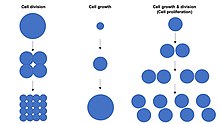Tissue growth
This article needs additional citations for verification. (July 2020) |

Tissue growth is the process by which a tissue increases its size. In animals, tissue growth occurs during
How cell proliferation is controlled during tissue growth to determine final tissue size is an open question in biology. Uncontrolled tissue growth is a cause of cancer.
Differential rates of cell proliferation within an organ can influence proportions, as can the orientation of cell divisions, and thus tissue growth contributes to shaping tissues along with other mechanisms of tissue morphogenesis.
Mechanisms of tissue growth control in animals
Mechanical control of tissue growth in animal skin
For some animal tissues, such as mammalian
For other animal tissues, such as the bones of the
Hormonal control of tissue growth in the entire animal body
Although different animal tissues grow at different rates and produce organs of very different proportions, the overall growth rate of the entire animal body can be modulated by circulating hormones of the
Developmental control of tissue growth during adult tissue homeostasis
Adult animal tissues such as
Regenerative tissue growth after wounding or other types of damage
Upon tissue damage, there is an upregulation in the activity of many pathways that control tissue growth, including the
